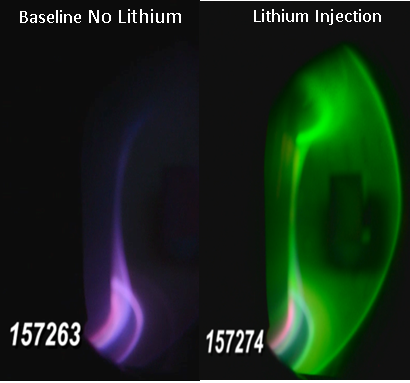Calming the plasma edge: The tail that wags the dog

Experiments on the DIII-D tokamak that General Atomics operates for the U.S. Department of Energy (DOE) have demonstrated the ability of lithium injections to transiently double the temperature and pressure at the edge of the plasma and delay the onset of instabilities and other transients. Researchers conducted the experiments using a lithium- injection device developed at the DOE's Princeton Plasma Physics Laboratory (PPPL).
Lithium can play an important role in controlling the edge region and hence the evolution of the entire plasma. For example, researchers have used lithium on the National Spherical Torus Experiment (NSTX) at PPPL and the EAST tokamak in China to improve the performance of the plasma. When lithium is injected, the boundary of the plasma emits green light, characteristic of lithium atomic processes (see figure to the right).
In the present work reported in a number of papers at the 56th American Physical Society Division of Plasma Physics Conference, New Orleans, LA, Oct. 27-31, 2014 [1], lithium diminished the frequency of instabilities known as "edge localized modes" (ELMs), which have associated heat pulses that can damage the section of the wall that is used to exhaust heat in fusion devices. The experiments injected lithium powder at low velocity from the top of DIII-D during plasma discharges, and compared the results with previous discharges done without lithium. DIII-D is optimally suited for this work since no lithium was previously present before these experiments, and world-class diagnostics on the device enabled careful evaluation of the direct effect of the lithium.
The tailored injections produced ELM-free periods of up to 0.35 seconds, while reference discharges without lithium showed no ELM free periods above 0.03 sec. The lithium rapidly increased the width of the pedestal region—the edge of the plasma where temperature drops off sharply—by up to 100 percent and raised the electron pressure and total pressure in the edge by up to 100 percent and 60 percent respectively. These dramatic effects produced a 60 percent increase in total energy-confinement time. Further work will focus on extending these high-performance ELM-free phases and uncovering the mechanisms by which lithium calms the plasma.
More information: [1] G.L. Jackson, et al., 56th APS DPP conference, Oct. 27-31, 2014, paper CO5.09; R. Maingi, et al., 56th APS DPP conference, Oct. 27-31, 2014, paper GP8.36; T.H. Osborne, et al., 56th APS DPP conference, Oct. 27-31, 2014, paper GP8.37; Z. Yan, et al., 56th APS DPP conference, Oct. 27-31, 2014, paper GP8.38 S.L. Allen, et al., 56th APS DPP conference, Oct. 27-31, 2014, paper CO5.06
Provided by American Physical Society




















